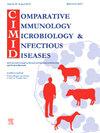犬种感染布鲁氏菌的一次常见暴发:血清学和分子调查
IF 2
3区 农林科学
Q4 IMMUNOLOGY
Comparative Immunology Microbiology and Infectious Diseases
Pub Date : 2025-10-02
DOI:10.1016/j.cimid.2025.102406
引用次数: 0
摘要
本研究旨在描述犬布鲁氏菌病的爆发在狗收容所的血清学和分子基础。受感染的狗表现为睾丸肿大、附睾炎、前列腺炎和睾丸炎。采用玫瑰孟加拉平板试验(RBPT)和缓冲酸化抗原平板试验(BAAPT)对所有犬进行布鲁氏菌病血清检测。对血清学阳性犬的血清和全血分别采用常规pcr、种特异pcr和多重pcr对流行的布鲁氏菌进行属、种和生物变异水平的鉴定。血清学试验阳性结果证实存在光滑布鲁氏菌。RBPT和BAAPT检测布鲁氏菌抗体的血清总阳性率为56.7% %。针对免疫优势抗原bp26基因的引物序列进行分子鉴定,在属水平上证实了布鲁氏菌。犬种特异性实时pcr结果证实犬血清中存在犬利氏杆菌DNA。多重PCR扩增出3个特征片段,分别为587 bp、1071 bp和1682 bp。微量调查显示,狗的生肉饮食是最有可能的感染源。本文章由计算机程序翻译,如有差异,请以英文原文为准。
A common source outbreak of Brucella melitensis infection in male dogs: Serological and molecular investigation
The present study aims to describe an outbreak of canine brucellosis in a dog shelter on serological and molecular bases. The infected dogs exhibited testicular enlargement, epididymitis, prostatitis, and orchitis. All dogs were serotested for brucellosis using Rose Bengal plate test (RBPT), and buffered acidified antigen plate test (BAAPT). Serum samples and whole blood of serologically positive dogs were subjected to conventional, species-specific real-time, and multiplex PCRs to identify the circulating Brucellae on genus, species, and biovar levels, respectively. Positive results from serological tests confirm the presence of smooth brucellae. The overall seroprevalence of Brucella antibodies was 56.7 % as detected by RBPT and BAAPT. Molecular identification using primer sequences targeting the Immunodominant antigen, gene bp26 confirmed Brucella on the genus level. Results of species-specific real-time PCRs confirm the presence of B. melitensis DNA in blood sera of dogs. Multiplex PCR has amplified three fragments of 587 bp, 1071 bp, and 1682 bp characteristic for B. melitensis biovar 3. Trace investigation revealed that the dog's raw meat diet was the most likely source of infection.
求助全文
通过发布文献求助,成功后即可免费获取论文全文。
去求助
来源期刊
CiteScore
4.60
自引率
0.00%
发文量
102
审稿时长
40 days
期刊介绍:
Comparative Immunology, Microbiology & Infectious Diseases aims to respond to the concept of "One Medicine" and to provide a venue for scientific exchange. Based on the concept of "Comparative Medicine" interdisciplinary cooperation between specialists in human and animal medicine is of mutual interest and benefit. Therefore, there is need to combine the respective interest of physicians, veterinarians and other health professionals for comparative studies relevant to either human or animal medicine .
The journal is open to subjects of common interest related to the immunology, immunopathology, microbiology, parasitology and epidemiology of human and animal infectious diseases, especially zoonotic infections, and animal models of human infectious diseases. The role of environmental factors in disease emergence is emphasized. CIMID is mainly focusing on applied veterinary and human medicine rather than on fundamental experimental research.

 求助内容:
求助内容: 应助结果提醒方式:
应助结果提醒方式:


